Overview:- Blogging coach Yaro Starak switched to Ontraport and used it to sell over a million dollars of his education products like online courses.
In this Ontraport review he explains how he first tested Ontraport by sending emails during the free trial period, set up advanced features like upsells, downsells, an affiliate program, how much he pays for Ontraport, and whether he would recommend it to other online coaches.
I have an online coaching business where I teach people how to use email marketing and a blog to sell education products online. To make money I sell an online course, a membership site and a few smaller products like ebooks.
Over a long career I've helped thousands of people transform their knowledge into a profitable online coaching business in a diverse range of niches including treating acne, speed reading, sports betting, multiple personality disorder, personal training, cosmetic chemistry, drama lessons, color weaving and book publishing.
It all started with just me and a blog, and shortly after that, an email newsletter powered by Aweber.
A few years ago I made the decision to change the technical system I use to run my online coaching business because I was looking for a way to reduce the number of different tools I had to combine.
I didn't like using separate software to run my affiliate program, email newsletter, shopping cart, membership site, and so on.
I called this Frankenstein syndrome, trying to make all these different tools work together creating a monster.
It cost me thousands of dollars in contractor fees to setup each tool and get them to play nicely (and still there were constant bugs!). I was tired of it and wanted to streamline things, especially as I planned to release a new Flagship Course.
As I began my search for an Aweber alternative, the platform I was almost certain I would switch to was Infusionsoft (now known as Keap).
Many experts and friends I knew in my industry were using Infusionsoft. It seemed like a great all-in-one solution, even though it was pricey.
At the time, I had barely heard of Ontraport. As someone who tends to choose platforms based on what others talk about the most, it wasn't high on my list.
Aweber Was All I Needed For A Long Time
For seven years I relied on Aweber as my email newsletter tool.
Overall I was very happy with Aweber. I used it to sell over a million dollars of my online courses from 2007 to 2012, and besides a couple of times when there were temporary delays sending emails, it was very reliable.
I used Aweber to send a weekly free newsletter and to set up various automated email sequences, some to deliver lead-nurturing content to sell my courses, and a couple of sequences for my paying customers.
I first discovered Aweber back in the mid-2000s when I was the founder of a small online essay editing company. I signed up for a free trial and setup an automated email followup sequence to promote my editing services.
Aweber didn't make much of an impact for selling editing services, however when a blog I started for fun took off (entrepreneurs-journey.com) and I switched to selling my own course online, Aweber became my main marketing tool (along with my blog).
After many years of steady growth, my online teaching business hit a plateau. At this time my courses were getting outdated, so I decided to shut them all down.
A couple of years later after taking a break from teaching, I decided to create a brand new Flagship Course. However, this time I wanted to implement more advanced marketing concepts I had learned about.
I wanted to test upsells, downsells, abandon cart triggers, other advanced marketing triggers and actions based on lead scoring.
Most of these things were difficult or impossible to do just with Aweber because Aweber was not a shopping cart, or affiliate platform and didn't have enough of the advanced triggers and integrations I wanted.
This is what lead to the decision to leave Aweber and look for a more advanced all-in-one marketing platform.
The Search For An All-In-One Marketing Platform
I began my search online for an alternative to Aweber with a few basic steps…
1. I made a short list of the main features I wanted the software to have, including:
- An advanced email autoresponder with no complaints about deliverability (a big deal — if my emails don't get through then I don't make money!)
- A built-in shopping cart with a simple to implement upsell and downsell feature
- Advanced tagging, so I could segment my database in many ways and thus send them targeted emails, offers, etc
- Automated triggers, so based on an action taken (clicking a link in an email, visiting a blog post, leaving a checkout page before completing purchase, etc) I could add or remove tags, move people to email sequences, send one time deals, etc
- Affiliate module so I could run large product launch campaigns for my new Flagship Course with affiliates promoting it
All these features had to be part of the one platform. I didn't want to try and connect a separate shopping cart to a separate email autoresponder and a separate affiliate system and so on.
2. I researched what people in my industry were using usually just by checking the end of any emails I received from their newsletters. I could see if they were using Aweber or Mailchimp or Infusionsoft or Ontraport, etc.
3. Searched Google for reviews, which usually led me to bloggers who wrote comparisons about different tools. This could be helpful to discover new tools, but often you could tell the person who wrote the review just wanted an affiliate commission because their comments were overtly positive or not very specific.
4. I asked on Facebook what my peers and followers recommended.
Initially this process made me feel overwhelmed because I unearthed all kinds of new platforms that I never heard of, which claimed to do what I needed.
All the sales pages for these products were compelling. They all sounded good, but it was hard to really know which was the best for my needs.
I've had the experience before when you read how a tool can do something, then after you sign up you discover it can't quite do what you want, or it's a big technical challenge to make it work.
To narrow down my options, I decided to focus on what my top mentors and colleagues use to run their online businesses.
This may not have been the most comprehensive selection criteria, but it helped simplify things. Plus these were people I could contact directly to ask for feedback about their experience with the software.
After completing all these steps Infusionsoft was still the leading option. It had the most people I knew using it, especially the more advanced marketers, and all the core features I wanted, all in one platform.
However, I was concerned about choosing Infusionsoft because of the learning curve. Some people called it “Confusionsoft” because of how hard it is to setup (although I hear they have improved usability in recent years).
One colleague told me Infusionsoft is very powerful, but be prepared to invest in having a full time employee manage it for you.
Ontraport showed up at this time as a tool a few respected leaders in my industry were using, including a friend and coach from Sydney, James Schramko.

This is me (Yaro Starak) at a James Schramko conference in Sydney.
I contacted James and asked how he liked Ontraport, and in particular how difficult it was to setup some of the key things I wanted to do.
James was very positive toward Ontraport, and made comment how he had tried Infusionsoft first but then decided to leave the platform because it was just too complicated.
James reassured me that my list of main features were all available in Ontraport. He also made me feel like the learning curve would be far less and that I would not get confused.
This turned out to be the swing vote for me.
Although I intended to have my tech person setup my new marketing system for me, I wanted to be able to do the core things — like create and send emails — by myself. I also wanted to be able to understand how the tool worked, even if I wasn't the person setting it all up.
Ontraport seemed powerful enough, maybe not quite as advanced as Infusionsoft, but far simpler to get up and running with.
I decided to do a proper test with Ontraport.
How I Set Up Ontraport And Tested Email Deliverability During The Free Trial Period
I signed up for the Ontraport free trial and immediately began setting up my basic information.
I did a quick tour of all the main features. In particular I focused on the email creation tool since I would personally spend a lot of time writing emails with Ontraport.
One of the big concerns I had right away was email deliverability. Companies all say they have good deliverability, but until you test it with your email database you never really know.
During the trial period with Ontraport I wanted to send a couple of emails to my main house list (newsletter) to check the email open and click rates and make sure the numbers looked on par with what I was getting with Aweber.
With some help from Ontraport support, I imported my entire database from Aweber and did my best to tag all my contacts. I kept things pretty simple to start with making two groups – one of customers and one of prospects.
I then used the email editor to create my first newsletter. Adding a logo/images and basic text formatting was easy enough. Later I would ask my tech person to setup a couple of email templates we would use over and over again, but for my test I just needed something basic.
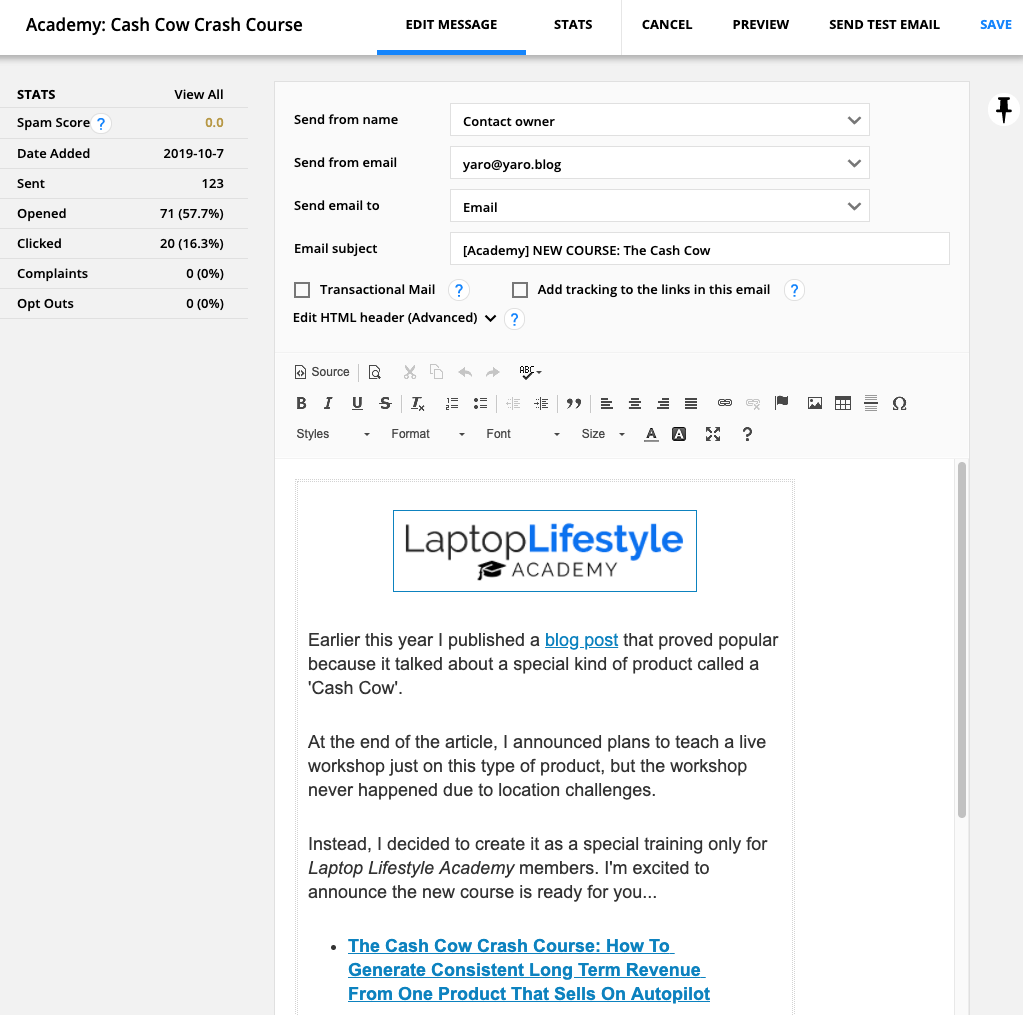
The Ontraport email editor is simple to use, but can be edited in HTML source mode if you want complete style control.
I wrote my newsletter, sent myself a test email to make sure it looked right and the links worked, then went through the process to send the email to my entire prospects database.
A couple of days later I checked the stats on this email and the open and click through rates were holding true to the results I get with Aweber, which was a big relief.
I didn't have a big drop in response rates or sudden surge in spam complaints, which was my main concern about making this change in email provider.
Because I cleaned my list of dead subscribers during this change over process, I ended up getting slightly higher open and click through rates with Ontraport over time. Ontraport also has a built-in email campaign for automatically cleaning your list and re-engaging unresponsive subscribers.
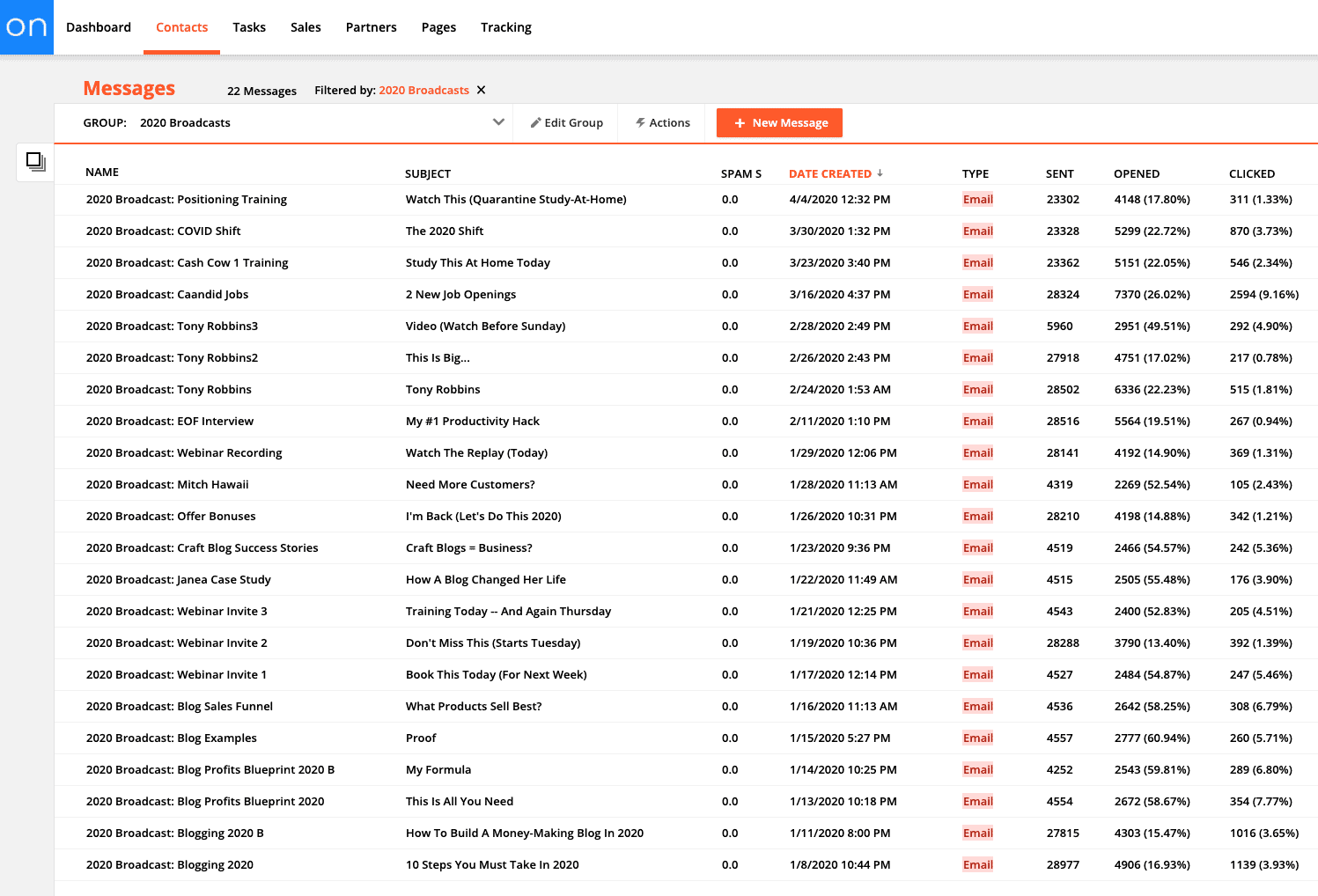
A screenshot of some of the newsletter broadcasts I made with Ontraport in 2020, including open and click-through data.
Next I investigated all the main features I planned to use, including the affiliate module, how to create products and how the one-click upsell and downsell offers work. I also looked into the tag triggers to see what my options were.
At first it was all very confusing. You can't just login and instantly know how everything works. I had to watch training videos to get a feel for the potential, but even after that I didn't feel I could do it all myself — but that was okay. I knew my tech person would be the one setting up most things, I just needed a basic understanding of how it worked.
Watching the training videos made me excited about what I could do with Ontraport. The power was there, and I planned to use the years ahead to tap into as much of it as I could as I created new digital teaching products.
Once the trial period ended I felt confident Ontraport could do everything I needed it to, and far more. Still to this day I haven't taken advantage of many of the features.
The most important thing I needed immediately though, was to send emails, and that I felt very confident about doing with Ontraport.
Working With Ontraport To Sell My Products Using Upsells, Downsells And Triggered Campaigns
As I mentioned earlier, I was re-starting my online coaching and teaching business to coincide with the switch to a new marketing platform.
At the time my blog and email list were still active, but I had no products for sale.
To get my company up and running again I released an audio subscription product (interviews with entrepreneurs) and then wrote a series of ebook packages (one on mindset and productivity, one on blog traffic and another on how to invest in websites as a side hustle).
These were the first products I sold with Ontraport. My plan was to use the audio subscription as an upsell when people bought the ebooks.
Here's how it would work:
People would hit the checkout and order the ebook package (book + bonuses), then on the post-purchase page they would see a one-click yes/no option to add a free month subscription to my audio program, then get charged the monthly fee to remain subscribed from the second month onwards.
They only had to enter their credit card for payment once, any upsell purchases (if they clicked YES) were automatically added to the same purchase, making for a seamless process just like McDonald's asking “if you want fries with that?“.
This was my first test of Ontraport's one-click upsell system, which could even work for multiple upsells (a second yes/no offer after the first) and downsells (if they click NO to the first upsell, making another offer, usually lower priced). In fact, it was the first time I'd ever offered any kind of upsell in my entire business career!
With some help from my tech person Carly, we were able to set this up to work using just Ontraport and Stripe as the payment processor.
I was super excited the first time a person bought an ebook and said yes to the free month subscription as an upsell.
Once I had written the three ebook packages, I was able to test multiple offers. For example, I offered one ebook package for $49, or all three ebook packages as a bundle for $99, and then upsold my audio subscription as a one month free trial.
This meant I could turn a one time $49 purchase into $99 upfront with a recurring $29/month fee, which usually lasted for at least three months (so a total of $186 transaction value – a significant bump!).
Over time my audio product turned out to not convert well and I decided to focus on a coaching membership site I called the Laptop Lifestyle Academy. Today I sell this product standalone and also as a free trial upsell, all using Ontraport.
While it took Carly and I a lot of extra work to set up the upsell and downsell pages, and the bundles on checkouts, once the work was down the impact was obvious. It always increased how much I earned per transaction.
After the ebooks and membership site were complete, I turned my attention to selling courses again, releasing my Flagship Course, Blog Mastermind 2.0.
I also began to roll out additional marketing triggers designed to increase sales of all my products.
For example, I used Ontraport to trigger an email sequence if a person went to a checkout page for my product, but then did NOT buy. This is called an abandon cart campaign.
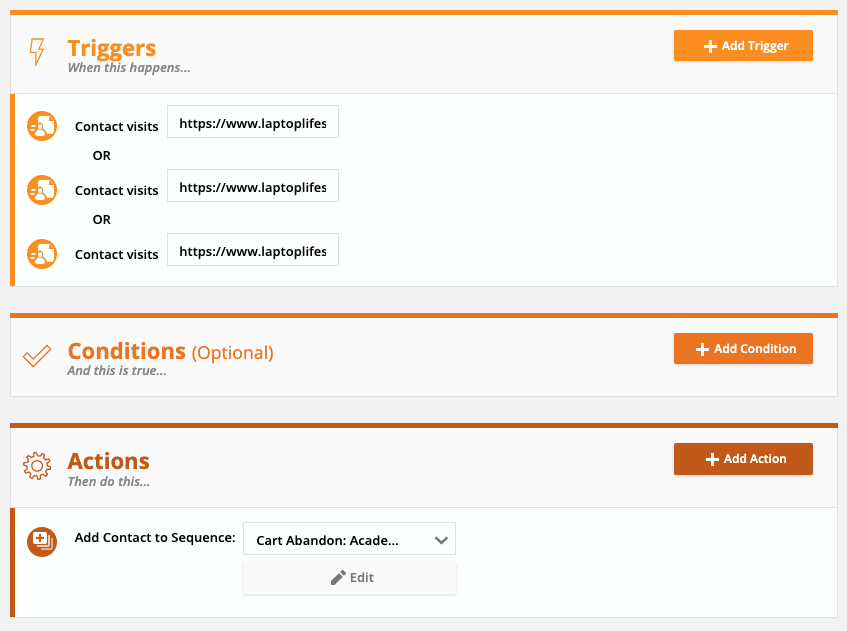
A trigger that goes off when someone visits the checkout pages for my product.
I also created what I call a second-chance campaign for all my upsell offers. This means if a person clicks the NO button to any of my upsell offers, they automatically go on to a second chance sequence, which will send them emails to again offer the upsell deal one more time a couple of weeks later.
You can see an example a second chance video I send out for my Laptop Lifestyle Academy membership. This is sent to people if they are offered membership as an upsell when buying another product of mine, but click the NO button.
These triggers were at times difficult to set up or even wrap my head around how they work!
For example, the abandon cart trigger needs the person to have opted in to my database so they have a record inside Ontraport, then when they reach my checkout page, there is Ontraport code on the page that sets off the trigger.
The abandon cart trigger is confusing because it goes off automatically when someone lands at my product checkout page. Even if they buy the product, they are still added to the abandon cart campaign.
However, 90 minutes later when the campaign starts, the very first thing it does is check whether that person is now on the customer campaign (has the customer tag) for that product. If they do have the tag, then they are removed from the abandon cart campaign since they must have actually purchased the product, they did not ‘abandon the cart'. If they do not have the customer tag, they start getting emails to bring them back to purchase the product.
I probably just confused you, but rest assured all these triggers and rules do work. Just don't expect all of it to make sense at first. There is plenty of support to help you figure it out if you get stuck (videos you can watch and people you can talk to at Ontraport).
Can Ontraport Run A Membership Site?
You might be wondering as you read this review how exactly Ontraport works as a membership site, or a content delivery platform.
Shortly before I was writing this review, Ontraport rolled out new membership site features, which include templates for building a membership site just with Ontraport alone.
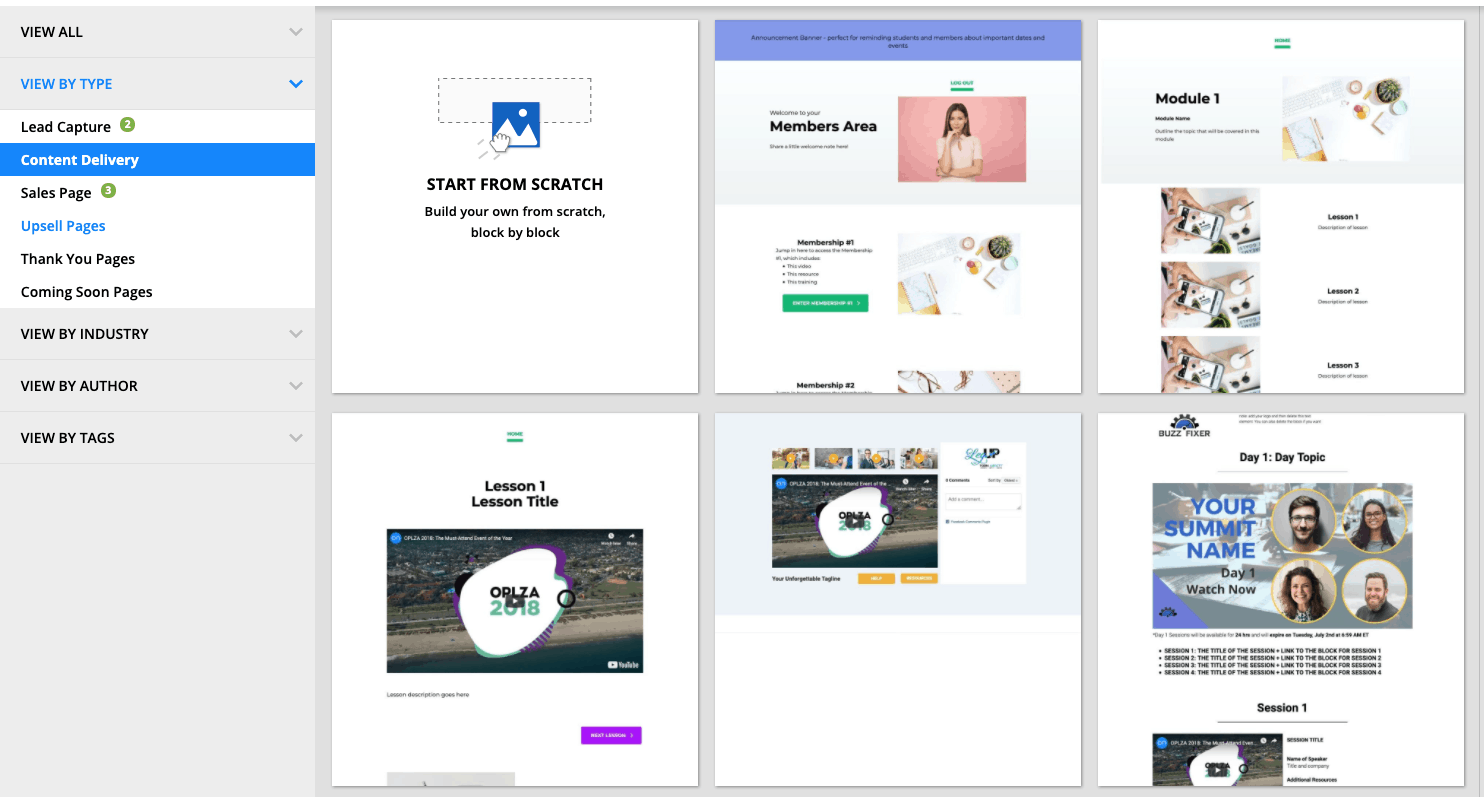
Ontraport has page templates for membership sites, but not very many as of this writing
I have not used this feature, but I presume provided you are comfortable using the templates Ontraport provides, it will offer the simplest setup option for protecting content/delivering products.
Prior to this, you had to integrate Ontraport with a WordPress installation (the blogging/CMS platform) using a plugin called PilotPress that Ontraport gives you, which is exactly what we did to deliver all my products.
Ontraport still has this feature, which if you are a regular user of WordPress like I am, you will find easy to use since it's just creating WordPress pages and posts. Plus you can design your site like you would any WordPress installation. I much prefer having this level of control compared to using the Ontraport page builder.
Today, anyone who buys a product from me receives a welcome email, with a custom generated password and their email address for login. They login, then can access a main product dashboard and then click through to access the product(s) they purchased.
The dashboard shows all the products I have for sale, but the ones they haven't purchased are greyed out and will take them to the product sales page if they click.
Here is a screenshot of my product dashboard:
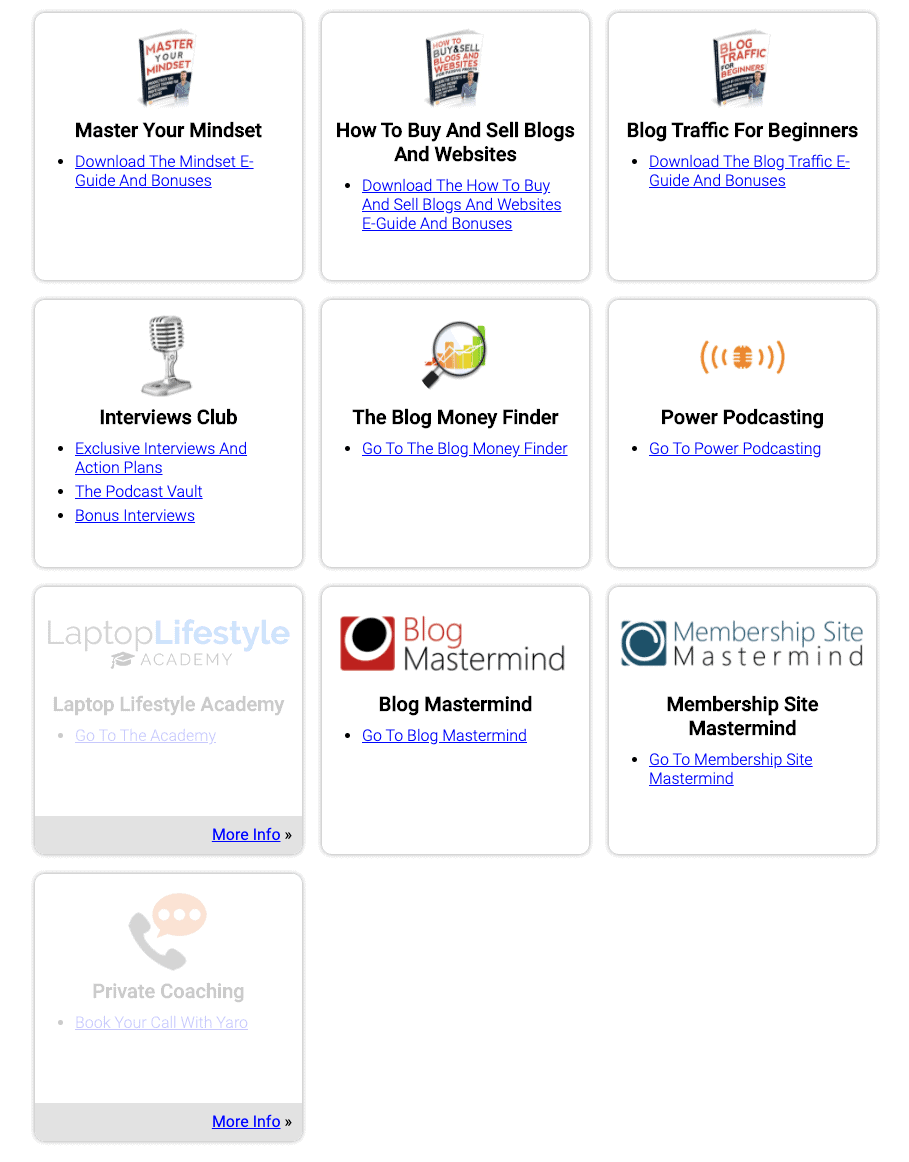
This is a snapshot of my product dashboard, built using WordPress + PilotPress, the Ontraport integration plugin
This page is on my WordPress site, but the password protection function is being controlled by Ontraport. Each product is delivered on a simple WordPress page only accessible if you purchased that product.
I don't have space to explain the entire membership protection system here in this review. Ontraport has plenty of help content on this. What I can tell you is that setting it up was beyond my technical skills, but I do understand how it works. It's definitely something you should hand over to your tech lead.
Carly my tech lead who handles my WordPress blog, also built my product dashboard using WordPress and Ontraport. She did the website layout, with my graphic designer doing product logos.
Important: Ontraport Is Not A Community Tool
Ontraport is good at protecting digital product, controlling membership levels and drip releasing content.
It's all seamless, from buying something via a checkout page powered by Ontraport, creating a membership level granting access in that customer's record in Ontraport, sending a welcome email with login details, controlling access to WordPress and drip releasing/opening new content as members move through a course/product experience.
However, Ontraport is not the kind of membership tool you use to run a fully-fledged community.
If you want something with a forum, direct messaging between members, advanced member profiles — basically a modern social-media style membership site, you're going to need to find third-party software.
I currently use the Invision Community software to run my Laptop Lifestyle Academy membership site, combined with Ontraport for sending emails to members. It's not a seamless integration, but I wanted to build out a proper community site I controlled so needed custom software.
If you just want to password protect product delivery, drip release/unlock content over time and send it out via email sequences, with each customer having their own login, Ontraport can do this right out of the box.
For a basic membership or subscription site, Ontraport is all you need. For something more complex, you need a dedicated community platform.
Using Ontraport For A Big Affiliate Powered Launch Campaign
When I reached the point where I was ready to sell my Flagship Course, Blog Mastermind 2.0, my plan was to do a big affiliate supported launch.
This meant I'd release a brand new free report for affiliates to promote, I'd need a special ‘affiliate portal‘ for affiliates to login to and access all the promotional tools, and an affiliate sign-up page to recruit new affiliates and show them the schedule for the launch, affiliate prizes, etc.
Much of what I hoped to do rested with the affiliate module in Ontraport.
I'll be honest, while theoretically I thought Ontraport could do all that I wanted, this was definitely an area I felt lost. It's not an easy part of the software to figure out.
If it wasn't for Carly, who could dive into Ontraport and ask technical questions of Ontraport support as needed, there's no way I could have done it myself. If you're not super-technical, then you need to have tech support to make this part of Ontraport work for you.
Like with delivering products, the Ontraport affiliate module works with WordPress. For example, to create an “affiliate portal” — basically a membership area just for affiliates — I have another separate WordPress installation, which is connected to Ontraport via their plugin for WordPress.
People sign up at that page to create an affiliate account (powered by Ontraport), then once they login they see their own affiliate links, all the promotional tools and reporting on their results (clicks on links, sales, commissions etc). They also receive a welcome email with their login details, and go on to my affiliate email list segment.
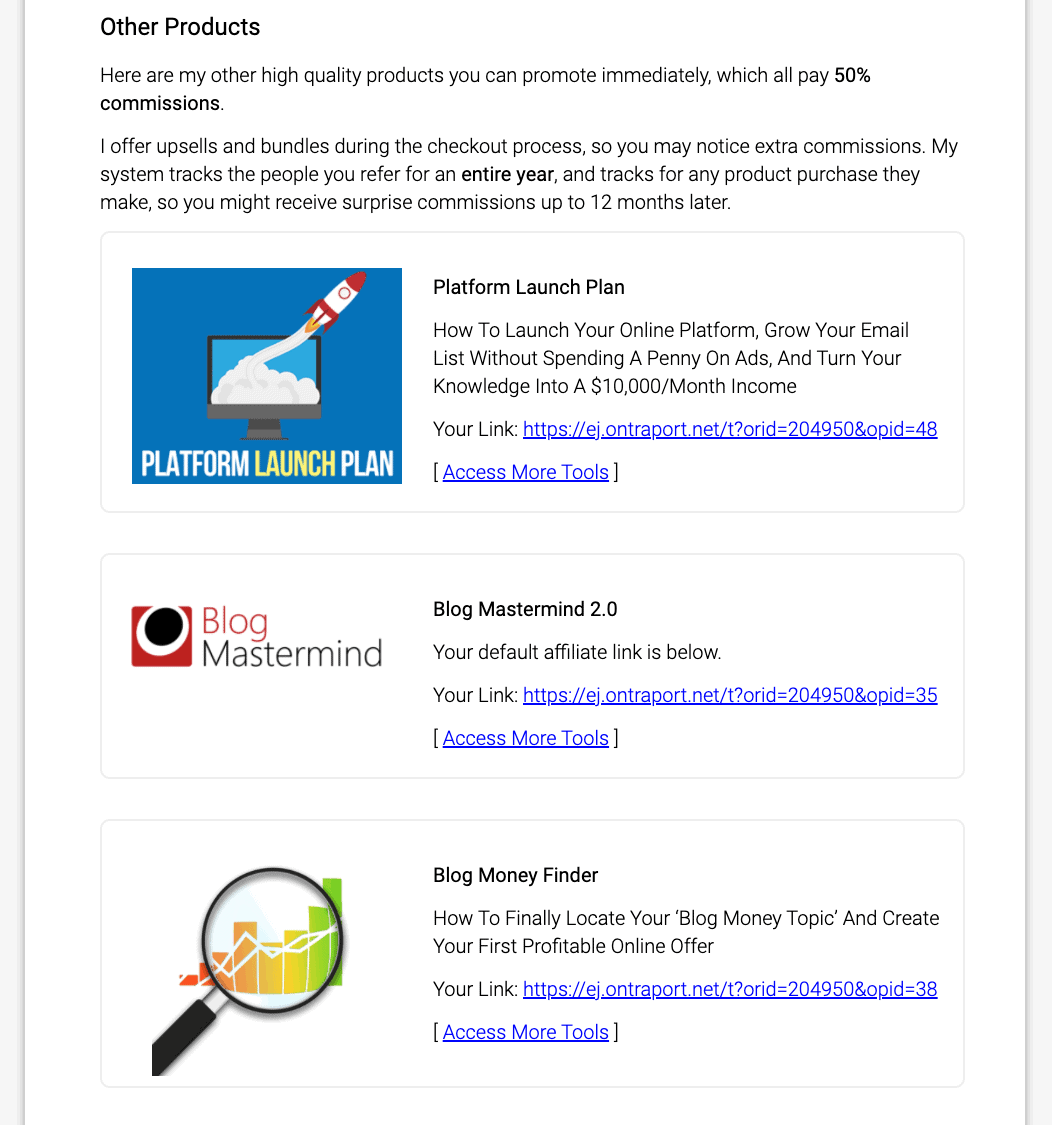
A snapshot of inside my affiliate portal, showing some of the promo tools my partners can promote to earn commissions
What really mattered to me was being able to let affiliates promote my key resources, for example a video or a blog post or a landing page for a webinar, and set their tracking cookie so if they make any sales in the future, they get credit.
Ontraport has the ability to do this by creating custom tracked links for any URL you want to send people to. For example, this is an affiliate link to my webinar signup page:
If someone clicks this link, then buys my course while watching the webinar, that affiliate will get the commission (triggered when the customer buys via the Ontraport powered shopping cart).
During the launch I ask affiliates to promote many different things over a two week period, each one building on to the next. This is why it's so important I can give affiliates links to basically anything, and then they get credit for any sales that come in — even years later!
I did a small launch campaign this year (2020), and two of my affiliates made sales even though they were not promoting. The last time they promoted for me was over three years ago, but because Ontraport tracked their referrals inside my contacts database, when they purchased, they got the commission.
Like most parts of Ontraport, the platform can do a lot, once you figure out how to use it. I've given you a brief overview of what we do in my affiliate program. If I have left you with more questions just ask me here and I'll do my best to reply.
How Easy Is It To Create Web Pages In Ontraport?
We never used the Ontraport built-in page builder because we already had our pages built either in Leadpages, Thrive Themes, Thrive Cart, Divi Themes or custom WordPress designs.
It was easier to just swap out the Aweber code and replace it with the Ontraport code to collect subscribers and customers, rather than create all new opt-in pages, checkouts, etc.
I did however test out the landing page designer in Ontraport because I wanted to see whether I could use it without needing help from Carly my tech person.
Ontraport, like most systems for email marketing, has a range of template designs you can modify for pretty much every web page need you will have. Some example templates they include:
- Free ebook opt-in page
- Webinar signup
- Physical product page
- Coming soon page
- Video landing page
- Vacation destination
- Product launch
- Magazine
They also have page templates for checkouts, upsells, downsells, bumps, content delivery, membership sites and a lot more.
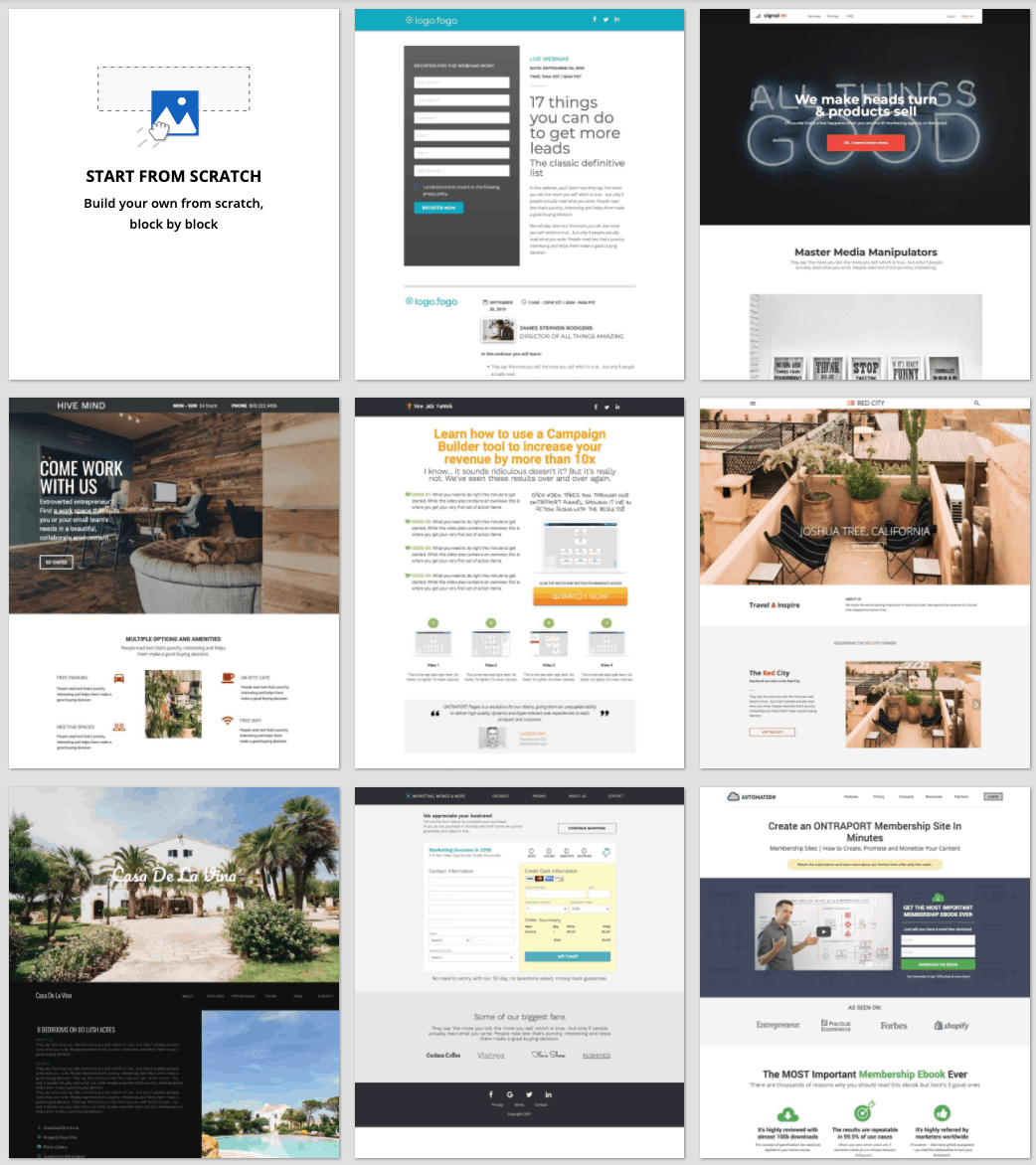
Ontraport comes with modern templates you can customize as you see fit
I can say the designs look good, on par with most modern web design. However, I wouldn't call the Ontraport editor the easiest tool for designing. It's not the worst I've used, but not the best either.
Doing the basics, like swapping out images, changing fonts, moving and removing elements is easy enough. For me, this is all I would need since I'd just be modifying the templates as they currently exist.
The more significant the changes you want to make, the more time you're going to spend getting everything to look right. It's fair to say you don't need to be a coder to make the templates look good, and that's probably the most important thing.
One word of warning, some of the templates are not free – they have one off prices like $27 for a sales page template.
The free templates are good enough in my mind, but I wanted to make sure you were warned as it can be a shock to have pay more money for something you already pay for!
The Ontraport Campaign Builder
The other part of Ontraport you will spend a lot of time in is the campaign builder.
When I first signed up for Ontraport they didn't have a campaign builder. Instead you used email sequences with triggered rules and tags.
For example, here is one of my email sequences that sells my blog traffic ebook package:
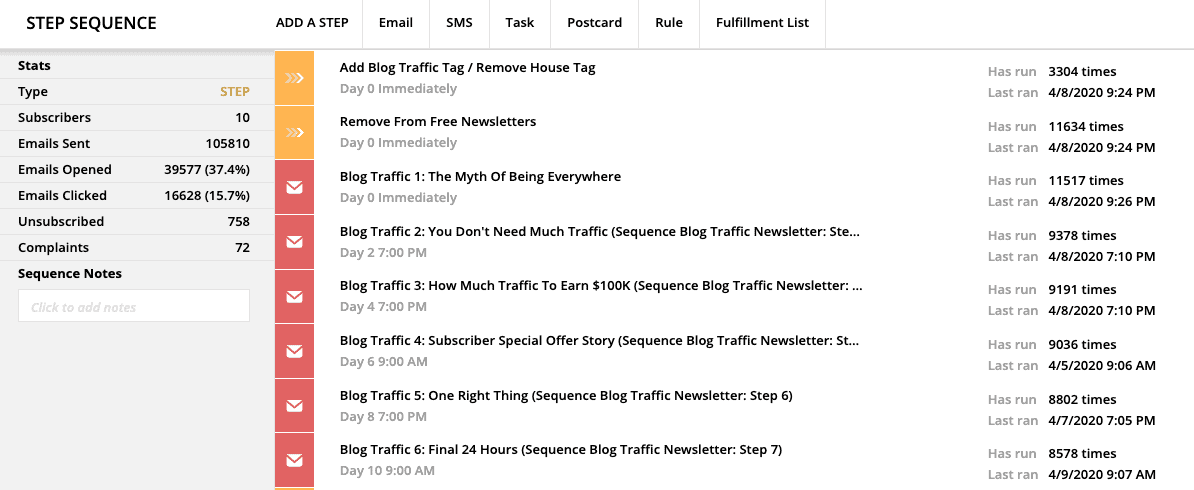
This is my email sequence in Ontraport that sells my blog traffic ebook package
This delivers a series of drip release emails on autopilot over a predetermined period of days.
I can also use this tool to send SMS messages, paper postcards via snail-mail and add tasks (Ontraport is a CRM, so you can use it like a SalesForce style contact management tool).
The sequence builder is still available in Ontraport and it powers most of my business.
When Ontraport rolled out their new campaign builder, we started using it instead of the email sequence builder. It does basically the same thing, but integrates rules and triggers in an easier to understand visual builder.
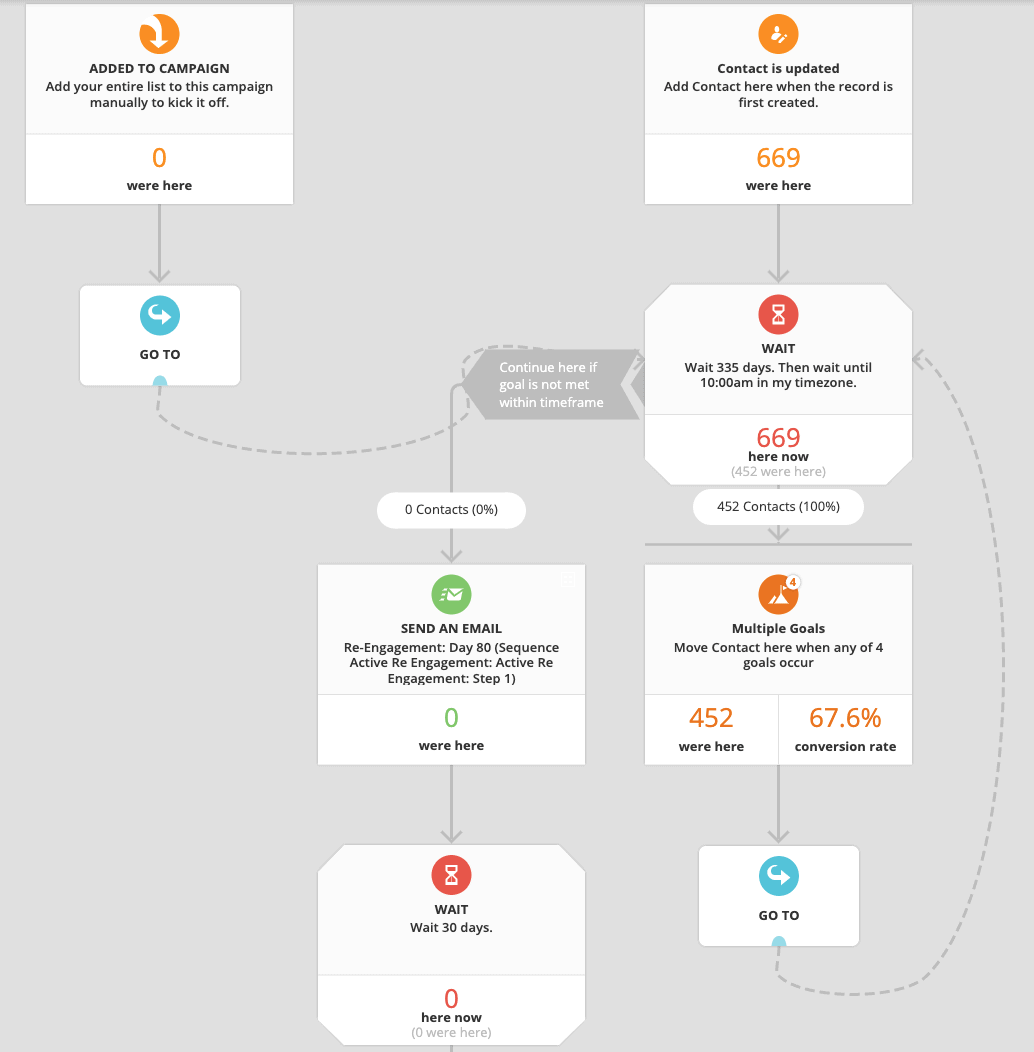
If you start using Ontraport now most likely you will use the Campaign builder as the main tool
If you're familiar with flow charts, the campaign builder will make sense to you, at least conceptually.
You use the campaign builder to control the experiences your contacts go through.
Presently in my business we have basic campaigns setup that run my newer email sequences, which do exactly the same as what we did with the sequences builder in Ontraport.
A person signs up via a landing page or a blog form, gets tagged appropriately so we can segment them, then goes through the campaign, triggering emails to be sent.
That is a basic use of a campaign. Things can get WAY more complicated.
Ontraport provide some pre-built campaigns, for example one for cleaning and re-engagement of your list as I mentioned earlier, which I use.
The sky is the limit with the campaign builder, which is a good and bad thing. It's like an all you can eat buffet but you only have one plate to eat from at a time, so you have to get very clear on what you want.
I'll leave it to the Ontraport team to better introduce more of the features of the campaign builder here in this hour-long video:
The campaign builder is incredibly powerful, but like many of the features in Ontraport, you probably won't use most of it to begin with. I don't.
It's worth learning what it can do so you have goals to aim towards. Just be careful about feeling overwhelmed.
I recommend you have a core list of features you intend to use short term so you can focus testing these elements only. Anything else is just a bonus for the future.
Tracking Your Numbers In Ontraport
Ontraport actually has some pretty incredible tracking abilities. It can even figure out LTV for you – that's Life Time Value of a customer, the ‘holy grail' of marketing metrics.
I view my Ontraport metrics dashboard daily. It's a broad overview of all the numbers that matter most.
In my dashboard we have it setup to show how many new email signups I get each day, week, month etc, all broken down by segment (I have a number of different prospect email campaigns people can join so it's important to know how they are doing).

Here's a screenshot of part of my Ontraport metrics dashboard
The dashboard also shows me total sales, sales by individual product, refunds, number of emails sent and unsubscribes. You can configure the dashboard to show basically anything Ontraport knows.
Bear in mind the dashboard is what it is, a bunch of numbers showing exactly how things are going day-by-day. It's simple, there are no graphs or charts. You can click any of the numbers to find the very specific details (like all the contact records of people who joined your list just today).
There are other reports you can generate from the Sales section of Ontraport. The individual campaigns also track data, so you can isolate how many people have entered a ‘funnel' in your business, and how many are currently at each point in the funnel. This is a more visual presentation of your data, and helpful for determining what point is breaking down.
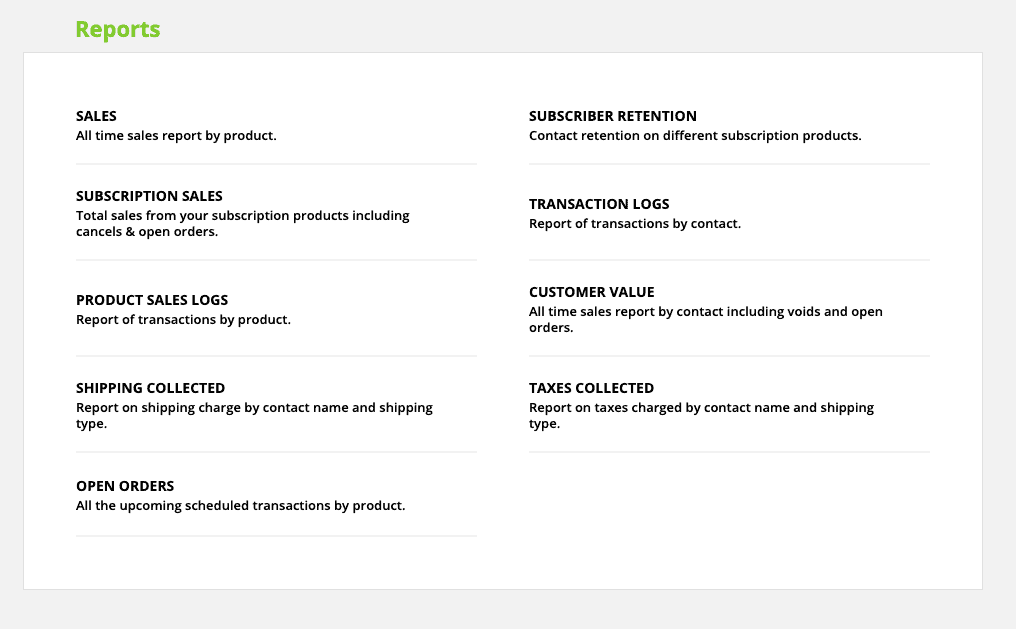
The sales reporting section in Ontraport has various reports you can generate, including the product sales logs, which is the one I view the most
How Much I Pay For Ontraport
After the Ontraport free trial was over, I switched to a $297/month plan, but that wasn't enough to cover my usage.
I had almost 100,000 contacts in my database and I was sending as many as 200,000+ emails a month when I first switched to Ontraport.
I was charged an additional $99/month to cover my large database and each time I went over 100,000 emails sent in a month, which usually happened at least once a month, sometimes twice if I was doing a big marketing campaign, I was hit with another $99 fee. Ouch.
This was still less than Infusionsoft quoted me at the time, but far more than I was paying for Aweber.
Ontraport pricing in 2020 – I had to go with custom pricing as my database was larger than 20,000 subscribers.
After a couple of years with Ontraport I switched to a yearly plan, which is what I pay now – $2,970 USD per year.
I still pay an extra $99 a month each time I send over 100,000 emails a month (and again at 200,000/month), so really the true yearly cost is well over $4,000 USD a year.
There is a very good chance you will pay less assuming you have a smaller database of contacts and don't send as many emails as I do. The entry level plan is $79/month, but that is for a small database of just 1,000 contacts.
You can see the Ontraport pricing page for current pricing info.
The Good, The Bad And Why I Decided To Stay With Ontraport
After using Ontraport for many years now (and selling over a million dollars worth of information products with it), I can conclusively say it's pretty much held true to my expectations.
Ontraport doesn't have the most beautifully designed interface, but it has done almost everything I've asked of it over the years.
There are have been moments of extreme frustration, but usually with help from a solid tech person and a few support tickets with Ontraport, you get the problem solved pretty quickly. Ontraport email support usually responds within 24 hours and their live chat support is available during standard working hours.
In summary, here are my favourite parts of Ontraport:
- It's an all-in-one solution. I came looking to Ontraport so I'd have the power to do almost everything with one platform, and it's delivered on that.
- It's built for advanced marketers. The triggers, campaign builder, upsells, downsells, coupon codes, SMS, postcards, cart abandon and second chance features, while a chunk of work to setup, bring results.
- Email deliverability has been solid. I've never had concerns that Ontraport emails were not going to my subscribers. Provided you keep your list clean and use double-optin settings, you should expect the same.
On the other hand, Ontraport hasn't always made me happy, for example:
- I am not a fan of getting charged an extra $99/month for sending more emails. I approached their sales team recently about a discount and they didn't offer any help beyond suggesting list segmentation to get my sent email count lower.
- The interface design is not intuitive. For example, while writing this review I went in and looked at how we setup our affiliate system in Ontraport and I still couldn't figure it out.
- Tracking data and presenting it could be simpler. Besides the core numbers in my dashboard, which are pretty easy to understand, I just don't get much value from the metrics. That's partially my fault for not learning how to use all the tracking tools, but it would be nice to have something like an advanced dashboard with more graphics and charts generated for me, showing me things I really should know about but don't know how to generate myself.
Overall I've been happy with Ontraport. It's given me the power and range of tools to build an automation engine that has effectively sold my products and services for me, frequently while I did other things in my life like travel and sleep!
It's a very powerful tool at an entry-level price for a small business, but it's not for beginners. If you make use of even 20% of the features you can do a lot, with plenty of room to grow into the more advanced features.
Should You Choose Ontraport?
I'll end this review with some thoughts on who should and who shouldn't use Ontraport.
I'll start with the obvious: There is a big difference between paying $19/month for an email newsletter platform like Aweber and paying $199+/month for something more robust like Ontraport.
You have to be ready to make use of the tools to justify the cost. If all you want to do is send an email newsletter, stick with the options that are cheaper and focus on email, such as Aweber, Mailchimp and ConvertKit.
If you want a true all-in-one solution that can be managed by yourself and one part time contractor, Ontraport is a great choice. It's worth making the comparison with Keap/Infusionsoft, Kajabi and Kartra, all priced similarly and also all-in-on platforms.
The best place to start is with the Ontraport free trial. Two weeks is just about enough to get your head around how the platform works and consider how it stacks up to your other options.
If you get excited about the potential of Ontraport during the free trial, then it's probably a good fit. If you feel mostly stressed out, then maybe it's not.
Don't forget to factor in what your business will need to make good use of Ontraport…
- You're probably already writing email newsletters and follow-up campaigns. You will need to do even more of these for all the sub-sequences like cart abandon, second chance, re-engagement, and other small campaigns all powered by email.
- You will need to create upsell and downsell pages, and have enough different products that work well together as upsells and downsells.
- To really pull off an affiliate program you need to create a lot of promotional tools and run an entire email marketing campaign just to your affiliates to get them to promote. It's s big job, but can double the size of your company when done right.
There are many more ‘little things' like this that crop up that you need to configure and build as you start to make use of Ontraport. It's annoying at times, yet it also feels gratifying, like you are building something worthwhile. At least that's how I felt.
It is a big job to truly leverage a more advanced marketing platform, but when you have a vision for what your company might look like at the next level, the building process is actually a lot of fun.
For the most part, I enjoyed it, and I certainly couldn't have done it without Ontraport.
If you're not sure you're ready for something like Ontraport or you have questions about the features, please ask me a question here and I'll do my best to help.
Good luck with your business!
Yaro

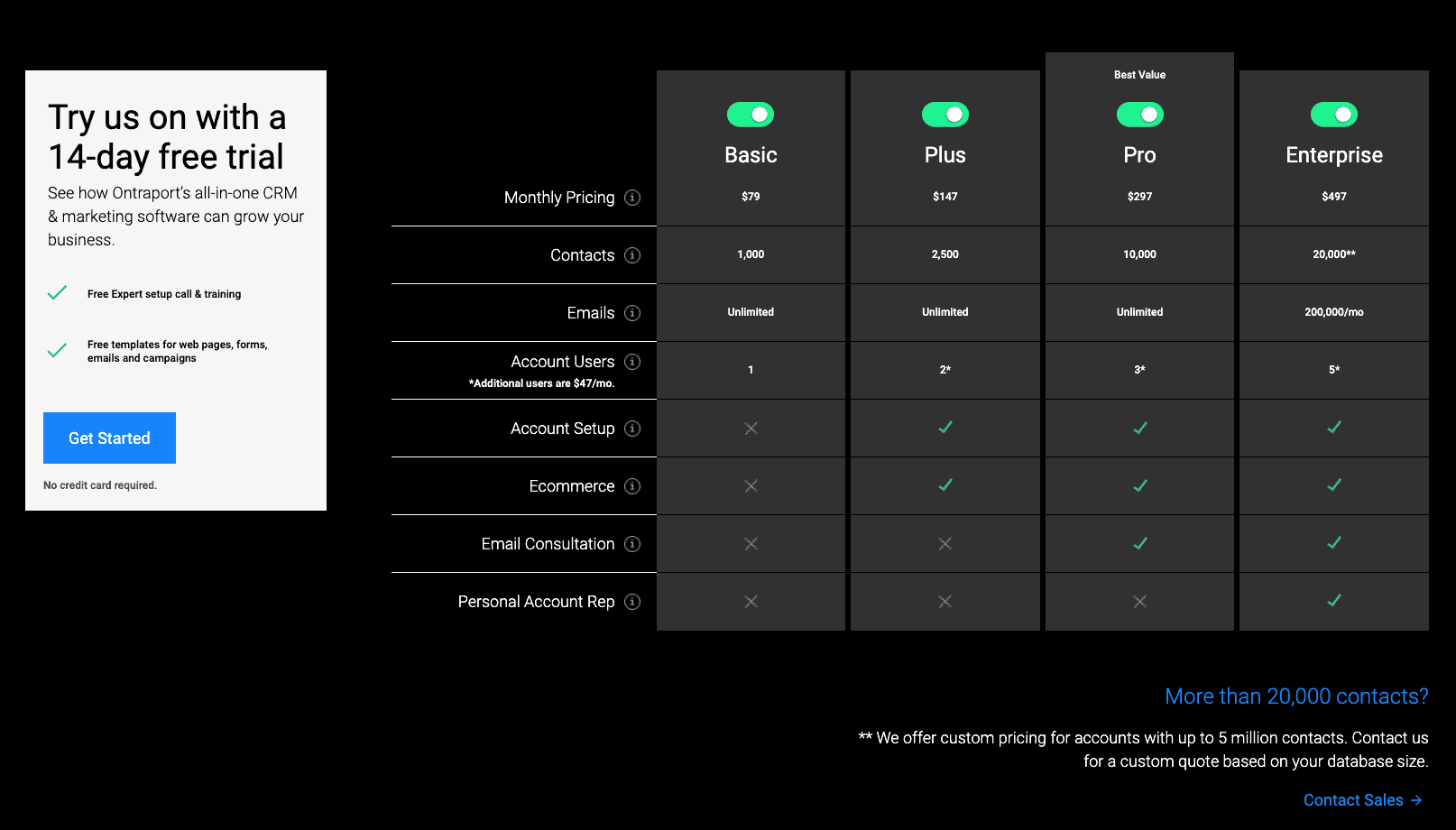
0 Comments